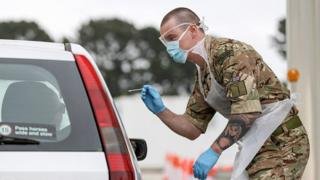
 Image copyright
Image copyright
MOD / PA
Many people in England are still waiting longer than 24 hours for their coronavirus test results, figures show.
Four in 10 tests done by mobile units and three in 10 carried out at regional drive-thru centres were taking longer than that, data up to 24 June reveals.
Prime Minister Boris Johnson said he expected such tests to be processed in 24 hours by the end of June.
But the data – the first released on 24-hour turnaround times – shows significant progress has been made.
Four times as many tests are being processed within a day as were being done at the start of June when the prime minister made his pledge.
He said 24-hours turnarounds would be achieved by the end of the month, apart from for those posted out – care homes and households can request postal kits if they do not want to use one of the testing centres.
How quickly are tests processed?
The Department of Health figures showed 24-hour turnaround performance of:
- 72% for 70 drive-thru centres, up from 19% at start of June
- 61% for 166 mobile units, up from 5% at start of June
- 22% for batches posted to care homes and 9% for home-test kits – although these processing times are affected by how quickly people use the tests
Alongside these testing routes, hospitals also test patients. More than nine in 10 of those are processed within 24 hours.
The figures released by the government also included performance for the contact-tracing system.
The results are broadly in line with previous weeks – one in four people who test positive does not engage with the contact tracers.
Of the 23,000 close contacts given by those who did, nearly 17,000 were reached and asked to isolate at home.
NHS Test and Trace chairwoman Baroness Dido Harding said “tireless efforts” were being made to improve the service.
She pointed out that for both mobile units and regional centres close to 100% were received within 48 hours.
“If you have coronavirus symptoms, get a test immediately. You can be confident that you will receive your result quickly.”
Local lockdown ‘not imminent in other areas’
Meanwhile, government sources have said no other areas are facing the immediate risk of a local lockdown, following the restrictions imposed in Leicester after a surge in cases in the city.
The latest figures for late June show there were 136 infections per 100,000 people in the past week.
Figures released by Public Health England have revealed the top 10 areas with the highest infection rates.
The next-highest, Bradford, has an infection rate three times lower. All those in the top five are experiencing falls in infection rates.
It mirrors what is happening nationally.
Overall infection rates have been falling since the prime minister signalled the first easing of restrictions in England on 10 May.
That marked the end of the stay-at-home message in England, paving the way for people to spend more time outdoors, see more friends and family and – from mid-June – for shops to reopen.
This weekend pubs, restaurants and hotels will follow suit.
Other parts of the UK have taken similar steps.
The number of confirmed positive tests reported is now a quarter of what it was in mid-May with fewer than 1,000 cases a day now being reported on average over the past week.
Although the government’s surveillance programme – run by the Office for National Statistics – suggests there is more virus circulating than the testing programme is picking up.
The latest figures show there are an estimated 3,500 new infections a day in the community in England.
This is likely to be linked to the fact some patients do not show symptoms or show very mild symptoms and therefore do not realise they are infected.
Although there are significant caveats around the findings – the estimates are based on small numbers of people testing positive – only 12 out of over 23,000 people were infected.


